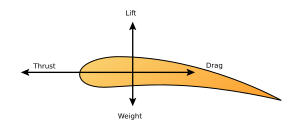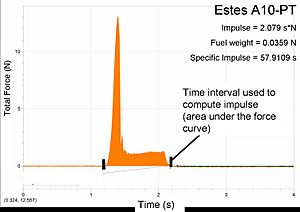Thrust facts for kids
Thrust is a powerful pushing force. When something pushes or moves mass in one direction, an equal pushing force, called thrust, happens in the opposite direction. This idea comes from Isaac Newton's third law of motion. Thrust describes how strongly an engine pushes. It's used for many vehicles and engines, like rockets, motorboats, propellers, and jet engines.
Thrust is measured in different ways. In the U.S., it's often measured in "pounds of thrust." In most other places, it's measured in newtons. About 4.45 newtons of thrust is the same as 1 pound of thrust. Imagine how much push it would take to hold a one-pound object still against Earth's gravity – that's one pound of thrust!
Contents
How Thrust is Different from Power
People often wonder how to compare the thrust of an airplane engine with the mechanical power of a car engine. It's tricky because they measure different things.
A car engine, or a piston engine in many propeller planes, doesn't directly push the vehicle. Instead, it turns a propeller or wheels, which then move the vehicle. So, these engines are measured by how much power they give to the propeller or wheels.
However, a jet engine works differently. It has no propeller. It pushes the aircraft by shooting hot air backward. To measure how much work a jet engine does, we look at the power it gives to the aircraft through its thrust. This is called "propulsive power."
Power is about how much force it takes to move something over a distance, divided by the time it takes. Think of it like this:
Here, P is power, F is force, d is distance, and t is time. For a jet or rocket engine, the force is the same as the thrust it makes. Since distance divided by time is speed, we can also say:
In this formula, T is thrust, and v is speed. This shows that the power a jet engine delivers increases as the aircraft goes faster.
What is the Thrust-to-Weight Ratio?
When we compare the thrust of a rocket or an engine to its weight, we get the Thrust-to-weight ratio. This number doesn't have any units because it's a comparison (a ratio). You get it by dividing the engine's thrust (in Newtons) by its weight (also in Newtons).
This ratio helps us understand how well an engine or vehicle performs. For example, it tells us how quickly something can speed up. It's a useful number for comparing different types of engines, like those in airplanes, jets, rockets, or even cars.
The thrust-to-weight ratio can change while an engine is running. This is because the vehicle gets lighter as it uses up fuel. When people talk about this ratio for comparing engines, they usually mean the number when the engine first starts.
Examples of Thrust in Action

An airplane creates forward thrust by pushing air backward. This push can come from the spinning blades of a propeller. It can also come from a fan inside a jet engine that pushes air out the back. Rockets create thrust by shooting hot gases out from their engines.
Reverse thrust is the opposite of forward thrust. It pushes air forward, which helps slow down the vehicle. Airplanes use reverse thrust to help them brake after landing. They do this by redirecting the engine's thrust or by changing the angle of the propeller blades.
Birds create thrust when they fly by flapping their wings. This pushes air downward and backward, moving the bird forward and upward.
A boat with a motor makes thrust (or reverse thrust) when its propellers spin to push water backward (or forward). The thrust then pushes the boat in the opposite direction.
A rocket is pushed forward by a thrust force that is equal to the force of the exhaust gas rushing out of its nozzle. This force from the exhaust gas is related to its speed. For a rocket to launch straight up, its starting thrust must be greater than its total weight.
| Engine | Thrust (Newtons) | Thrust-to-Weight Ratio |
|---|---|---|
| F-15C Eagle | 155,240 | 1.12 |
| F-16 Fighting Falcon | 76,300 | 1.095 |
| J-58 (SR-71 Blackbird Jet Engine) | 150,000 | 5.2 |
| Boeing 747-400 (Engines) | 1,008,000 | 6.3 |
| F-1 (Saturn V 1st stage rocket engine) | 7,740,500 | 94.1 |
Images for kids
See also
 In Spanish: Empuje para niños
In Spanish: Empuje para niños





